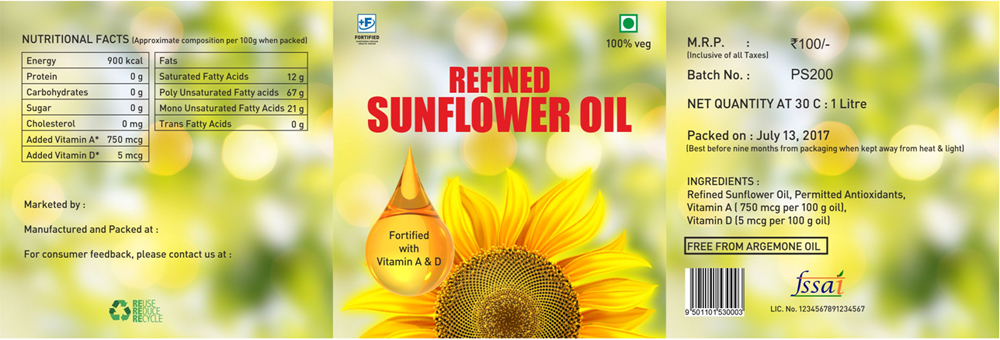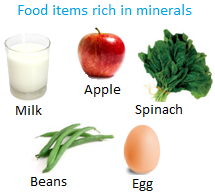45 minerals on food labels
Interactive Nutrition Facts Label - Food and Drug Administration Vitamins are organic substances that are naturally present in many plant and animal products. People obtain vitamins from both the plant and animal products they eat. The human body also makes vitamins D and K. There are 14 vitamins that may be listed on the Nutrition Facts label: biotin, choline, folate, niacin, pantothenic acid, riboflavin, thiamin, and vitamins A, B 6, B 12, C, … Understanding Food Labels | The Nutrition Source | Harvard … The information on food labels is intended to help consumers become savvy about their food choices. ... guar gum, carrageenan), or the scientific names of vitamins and minerals (e.g., ascorbic acid, alpha tocopherol). Ingredients like added sugars may carry many alternative names but are essentially varying combinations of fructose and glucose ...
Minerals In Food - Definition, Types, Sources and Examples A balanced diet prevents mineral deficiencies. The use of vitamin and mineral supplements should be discouraged to prevent any adverse effects. Also Read: Minerals. For more information on minerals in food, its definition types, functions and sources of minerals, and examples of minerals in food, keep visiting BYJU'S Biology. You can also ...

Minerals on food labels
Where are the vitamins and minerals on a nutrition labels? The Nutrition Facts label may include the following 14 minerals: Calcium, chloride, chromium, copper, iodine, iron, magnesium, manganese, molybdenum, phosphorus, potassium, selenium, sodium, and zinc are some of the minerals found in the human body. On a nutrition label, how are ingredients listed? › healthy-living › food-andVitamins and minerals - Food and nutrition | NHS inform Apr 30, 2020 · Three-quarters of the salt we eat is already in the food we buy, so checking the label and choosing foods that are lower in salt is one of the best ways to cut down. On food labels, there should be a figure for salt per 100g. High is more than 1.5g salt per 100g (or 0.6g sodium) Low is 0.3g salt or less per 100g (or 0.1g sodium) Daily intake Minerals Food & Drink Labels | Zazzle Zazzle's Minerals food labels make it easy to mark your leftovers, create expiration dates, and sweet notes on your kids' lunches. Shop our wonderful designs now!
Minerals on food labels. › managing › eat-wellFood Labels | CDC In general, eat more foods that are higher in vitamins, minerals (such as calcium and iron), and fiber. Eat fewer foods that are higher in added sugars, saturated fat, and sodium (salt), and avoid trans fat. Keep in mind that the % Daily Value of each nutrient, such as total fat of 10% in the example below, is based on eating 2,000 calories a day. › scripts › InteractiveInteractive Nutrition Facts Label - Food and Drug Administration Use the Nutrition Facts label as a tool for consuming a diet rich in vitamins and minerals. The Nutrition Facts label on food and beverage packages shows the amount in milligrams (mg) or micrograms (mcg) and the % Daily Value (%DV) for vitamin D, calcium, iron, and potassium per serving of the food. Food Labels | Nutrition.gov Food and Drug Administration (FDA) regulates the safety of food for humans and animals, including foods produced from genetically engineered (GE) plants, sometimes referred to as "genetically modified organisms" (GMOs). Find out more about the safety of GE plants, and how they are regulated here. Dietary Supplement Labeling Guide: Chapter IV - FDA This results in the following order for vitamins and minerals: Vitamin A, vitamin C, vitamin D, vitamin E, vitamin K, thiamin, riboflavin, niacin, vitamin B6, folate, vitamin B12, biotin,...
How to calculate percents of vitamins and minerals on nutrition labels? Biotin, choline, folate, niacin, pantothenic acid, riboflavin, thiamin, and vitamins A, b6, b12, c, d, e, and K are among the 14 vitamins that may be stated on the Nutrition Facts label. Minerals are inorganic substances present in soil and water naturally. How do you figure out how many macros are in a serving of food? Do food labels require vitamins and minerals? - JacAnswers Do food labels require vitamins and minerals? Labelling. Wherever a vitamin or mineral has been voluntarily added to a product, nutrition labelling is Nutrition and Supplement Facts Labels: Questions and … May 27, 2016, entitled “Food Labeling: Revision of the Nutrition and Supplement Facts Labels” (81 FR 33742; the “Nutrition Facts label final rule”) and “Food Labeling: Serving Sizes of Foods Vitamin, mineral daily requirements and good food sources -- Harvard ... RDAs, food sources for selected vitamins and minerals October 1, 2013 Recommended Dietary Allowances (RDAs) for selected nutrients commonly displayed on food labels
PDF Interactive Nutrition Facts Label - Vitamins and Minerals Chart wwwaovnutritioneucation Vitamins and Minerals Chart 1 Vitamins. VITAMIN WHAT IT DOES. WHERE IT IS FOUND DAILY; VALUE* Biotin ... • Conversion of food into energy • Digestion • Fluid balance • Nervous system function Olives ... Interactive Nutrition Facts Label - Vitamins and Minerals Chart How to find vitamins and minerals not listed on nutrition labels? The only micronutrients that must be listed on a food label are vitamin D, calcium, iron, and potassium. Other vitamins and minerals in the food can be listed voluntarily by food makers. Is it necessary to list vitamin E on a nutrition label? Minerals (for Kids) - Nemours KidsHealth Well, yes, but small amounts of some minerals are also in foods — for instance, meat is a good source of iron. Like vitamins, minerals help your body grow and stay healthy. The body uses minerals to to many things — from building strong bones to sending nerve impulses. Some minerals are even used to make hormones or maintain a normal heartbeat. Food Labels | CDC Apr 23, 2021 · Food Labels. Español (Spanish) Related Pages. Understanding the Nutrition Facts label on food items can help you make healthier choices. The label breaks down the amount of calories, carbs, fat, fiber, protein, and vitamins per serving of the food, making it easier to compare the nutrition of similar products. ... In general, eat more foods ...
How to Understand and Use the Nutrition Facts Label | FDA Overview. The information in the main or top section (see #1-4) of the sample nutrition label (below) can vary with each food and beverage product; it contains product-specific information ...
Vitamins and Minerals | Nutrition.gov Interactive Food Label: Vitamins and Minerals. HHS, Food and Drug Administration, Center for Food Safety and Applied Nutrition. How can the Nutrition Facts label help you to choose foods rich in vitamins and minerals? Use this interactive resource to find out! Vitamins and Minerals Chart ...
Understanding Nutrition Facts on Food Labels - WebMD Serving Size: An Important Part of Food Labels. At the top of the Nutrition Facts section, you'll see the serving size (such as 1/2 cup, five crackers, or 10 chips) and servings per container (such as two, four, six). The food label then lists the number of calories, grams of fat, grams of saturated and trans fat, etc., per serving.
› food-labelsFood Labels | Nutrition.gov Food and Drug Administration (FDA) regulates the safety of food for humans and animals, including foods produced from genetically engineered (GE) plants, sometimes referred to as "genetically modified organisms" (GMOs). Find out more about the safety of GE plants, and how they are regulated here.
kidshealth.org › en › teensFood Labels (for Teens) - Nemours KidsHealth A food with 5% or less of a nutrient is low in that nutrient. A food with 10%–19% of a nutrient is a good source of that nutrient. A food with 20% or more of a nutrient is high in that nutrient. The information on food labels is based on an average adult diet of 2,000 calories per day.
Changes to the Nutrition Facts Label | FDA The updated label appears on the majority of food packages. Manufacturers with $10 million or more in annual sales were required to update their labels by January 1, 2020; manufacturers with less ...
Food Labels (for Teens) - Nemours KidsHealth A food with 5% or less of a nutrient is low in that nutrient. A food with 10%–19% of a nutrient is a good source of that nutrient. A food with 20% or more of a nutrient is high in that nutrient. The information on food labels is based on an average adult diet of 2,000 calories per day.
Vitamins and Minerals | Nutrition.gov Interactive Food Label: Vitamins and Minerals HHS , Food and Drug Administration , Center for Food Safety and Applied Nutrition How can the Nutrition Facts label help you to choose foods rich in vitamins and minerals?
kidshealth.org › en › kidsMinerals (for Kids) - Nemours KidsHealth Well, yes, but small amounts of some minerals are also in foods — for instance, meat is a good source of iron. Like vitamins, minerals help your body grow and stay healthy. The body uses minerals to to many things — from building strong bones to sending nerve impulses. Some minerals are even used to make hormones or maintain a normal heartbeat.
How Food Labels Show Minerals and Carbohydrates - CardioMender, MD Potassium follows Sodium on the Nutrition Facts label and is essential to life. Potassium has many functions in our body. Among the most important are: Maintains fluid balance Controls electrical activity of the heart and other muscles Maintains optimal blood pressure by counteracting the effects of sodium Maintains acid to base balance
Interactive Nutrition Facts Label - Food and Drug Administration Interactive Nutrition Facts Label. ... Vitamins & Minerals; Ingredient List; Glossary; Resources; Fact Sheets; Explore the Nutrition Facts label and discover the ... U.S. Food and Drug Administration 10903 New Hampshire Avenue Silver Spring, MD 20993 1-888-INFO-FDA (1-888-463-6332)

Nutrition: Minerals Cheat Sheet Food Sources Infographic by marcella | Nutrition infographic ...
Daily Value on the New Nutrition and Supplement Facts Labels Feb 25, 2022 · However, they are required to list any vitamins and minerals that are added to the food or if a statement is made on the package labeling about their health effects or the amount contained in the ...
Vitamins and minerals - Food and nutrition | NHS inform Apr 30, 2020 · Vitamins and minerals are essential nutrients that your body needs in small amounts to work properly. Find out how much of the different types of vitamins, minerals and nutrients you should be consuming ... On food labels, there should be a figure for salt per 100g. High is more than 1.5g salt per 100g (or 0.6g sodium) Low is 0.3g salt or less ...
Food labeling: MedlinePlus Medical Encyclopedia VITAMINS AND MINERALS Vitamin D, calcium, iron, and potassium are the only micronutrients required to be on the food label. Food companies can voluntarily list other vitamins and minerals in the food. PERCENT DAILY VALUE (% Daily Value) Many nutrients include a percent daily value (%DV).
New Food Label Spotlight: Vitamins and Minerals In the updated label, that same section will jettison vitamin A and vitamin C (the FDA asserts, "In the early 1990's, American diets lacked Vitamins A and C, but now Vitamins A and C deficiencies in the general population are rare"), replacing them with vitamin D and potassium. Calcium and iron will remain on the label.
› media › 117402Nutrition and Supplement Facts Labels: Questions and Answers ... May 27, 2016, entitled “Food Labeling: Revision of the Nutrition and Supplement Facts Labels” (81 FR 33742; the “Nutrition Facts label final rule”) and “Food Labeling: Serving Sizes of Foods











Post a Comment for "45 minerals on food labels"